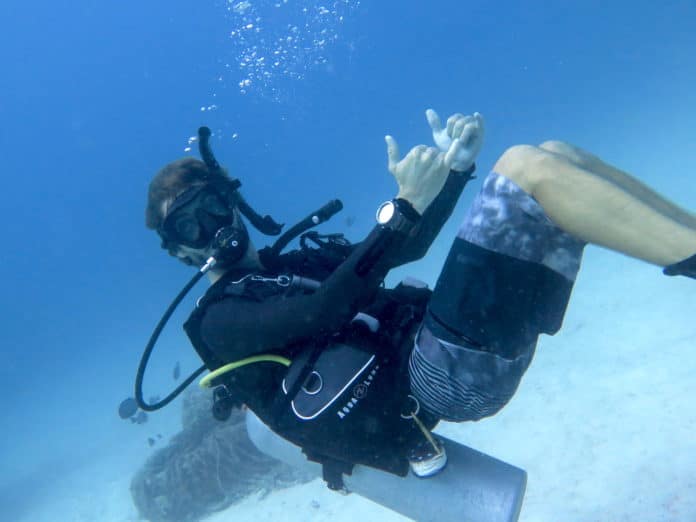You’ve probably heard of the term ‘SCUBA’ and wondered, what is scuba diving? Is it similar to snorkeling? No. Do you need special equipment or training for scuba diving? Well, yes, you do! And you have come to the right place to find out everything and anything scuba related.
What is Scuba Diving?
Scuba diving is a way to remain underwater, breathing from an independent air source, known as a ‘Self-Contained Underwater Breathing Apparatus.’
Read more about SCUBA acronyms and what they stand for.
Scuba divers carry their SCUBA with them and breathe from the compressed air in their tank. This allows them greater freedom underwater compared to ‘surface-supplied’ divers who use an umbilical cord connected to the surface.
Scuba diving also differs to freediving, an activity where the diver holds their breath underwater. This means scuba divers are able to remain underwater for longer due to their SCUBA equipment.
When was Scuba invented?
In 1942, Jacques-Yves Cousteau and Émile Gagnan invented and tested the first successful and safe open-circuit scuba, known as the Aqua-Lung. Their system combined an improved and safer on-demand regulator with high-pressure tanks filled with air. However, in 1952, Major Christian J. Lambertsen patented a modification of his original invention from 1939 (an underwater free-swimming oxygen rebreather apparatus) and coined the term, ‘SCUBA.’
What Equipment is used for Scuba Diving?
SCUBA was once used to refer to the actual breathing apparatus that enabled divers to breathe underwater. However, the term is now used to describe the whole general equipment setup for a scuba diver. This includes:
- Mask
- BCD
- Primary regulator and alternate air source
- SPG to check air
- Tank/cylinder
- Fins
- Weights
- Exposure protection; wetsuit, drysuit, or rash guard
- Snorkel
- Dive computer
- Compass
What Gas is in Scuba Tanks?

Some new divers refer to scuba tanks as ‘oxygen tanks’ but this is incorrect. Breathing pure oxygen while diving underwater will be toxic and very dangerous. Scuba tanks actually consist of ‘Air.’ This mix is very similar to the normal air that we breathe on land. According to NASA, this consists of:
Major : 78.08% Nitrogen (N2), 20.95% Oxygen (O2),
Minor (ppm): Argon (Ar) - 9340; Carbon Dioxide (CO2) - 410
Neon (Ne) - 18.18; Helium (He) - 5.24; CH4 - 1.7
Krypton (Kr) - 1.14; Hydrogen (H2) - 0.55
When we fill scuba tanks, the gas is usually 21% Oxygen, 78% Nitrogen, with the remainder being other gases.
You can get other mixes of gases in scuba tanks, such as Enriched Air, or various blends that is used in ‘technical diving.’
What is Scuba used for?
Scuba diving is mostly known as a leisure activity that allows divers to explore the underwater world. It gives you extended time underwater, and the freedom to swim around as your scuba equipment is attached to you.
However, scuba can also be used for commercial, scientific, military, and sport purposes. The appeal of the equipment allows scuba diving to have many uses.
Read our interviews with scuba divers and the various jobs they have in different industries.
Training for Scuba Diving
You will need some training to go scuba diving. This should be with a scuba diving professional. They will teach you the basics of scuba diving. This will cover how to use the scuba equipment and safety rules for scuba diving.
You do not need to be certified to go scuba diving. You can sign up for a scuba diving experience under the supervision of the dive professional. However, if you do enjoy it, you should get certified with a diving agency, such as PADI, SSI, RAID, or others, as this will allow you to dive around the world.
Do I need to be certified to go scuba diving?
What are some of the risks of scuba diving?
